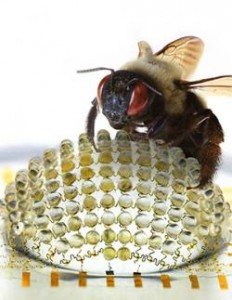The app accompanies book two (Molecules: The Elements and the Architecture of Everything) in a proposed trilogy about chemical elements in all their glory. A Dec. 10, 2014 news item on phys.org describes the app,
Although molecules make up everything around us, most people encounter these groups of atoms held together by chemical bonds in the pages of a textbook. They read text and see a drawing of chemical symbols or colorful circles—a one-dimensional view of the microscopic structures. Other representations have drawbacks as well: three-dimensional models are made of materials that can’t replicate the rapid and continuous molecular movement. Molecules are wiggling and jiggling in a never-ending dance, but you can’t see it, not even with the most powerful microscope.
“What is the best thing you could do to present (a molecule) to somebody?” asked Theo Gray, a scientist and author of “Molecules: The Elements and the Architecture of Everything.” “What’s the closest that you can come to actually handing it to them, so they could pick it up and look at it themselves?”
How about an app? In collaboration with the Theoretical and Computational Biophysics Group (TCBG) at the Beckman Institute at the University of Illinois, Gray’s company, Touchpress, has created an app for the Apple operating system (iOS) that brings molecules to life in a handheld device. Through the app, people can use up to eleven [?] fingers to examine in great detail more than 350 molecules, which they can also twist, turn, and tie into knots.
Gray has produced an entertaining and ‘jazzy’ video promoting his app (from theodoregray.com’s Molecules webpage where a link to the iTunes Download is provided),
A Dec. 10, 2014 Beckman Institute (University of Illinois) news release (also on EurekAlert) which originated the news item on phys.org, describes the objectives and the app itself more thoroughly,
“Every student who learns about typical molecules can do it now in a playful manner and realize that molecules are not dead and frozen, but that they move,” said Klaus Schulten, head of TCBG, and professor of physics at Illinois.
The app also allows users to vary the temperature and time scale in order to make the molecules move more quickly or more slowly. If the temperature is warm the molecules will move rapidly, while cold temperatures turn them sluggish, and absolute zero freezes them solid.
Getting molecules into everyone’s hands has been a goal for Gray. Even though Molecules is a beautifully illustrated book, Gray knows that the most stunning color photos and detailed descriptions can’t show the actual nature of molecules as well as looking at moving images of the material and the atomic motions themselves.
“In the case of molecules, you really can’t get a sense of what this stuff is like if you’re just looking at a picture: how goopy is it? Is it very runny or is it very thick? Is it like molasses or more like oil or more like water?” explained Gray.
“There’s also the fact that you can’t see molecules: they’re too small to see, and they’re too fast to perceive, but by providing an interactive simulation, you can give people really quite a good intuitive feeling for what a molecule is like and how it moves and how it behaves, and translate that into human scale.”
A chance meeting at a 2013 New Year’s Eve party between Gray and Barry Isralewitz, a TCBG research programmer, led to a discussion of molecular dynamic simulation. Isralewitz’s work with the TCBG involves simulating biological structures down to the atomic level. The group has created software packages VMD, which creates the visualizations, and NAMD, which simulates the movement of the structures. The software runs consecutively and in conjunction on powerful computing systems and is freely available to researchers around the world, who use it to model and simulate structures at detailed levels. Recently with the help of Blue Waters, a petascale supercomputer at the University of Illinois, TCBG unraveled one of the largest structures ever simulated—the HIV capsid, made up of 64 million atoms.
For the app, Touchpress created the visualizations, and TCBG provided the NAMD software. Taking the software into iOS, which can be used on iPhones and iPads, was not an easy task. The TCBG staff, including Jim Phillips, John Stone, and Christopher Mayne, among others, consulted regularly with Richard Zito, the main programmer from Touchpress, who lives in London.
“When Theo Gray came to us, he was full of enthusiasm, and we were actually a little hesitant. We didn’t know how well it would work out,” said Schulten. “But it worked very well, and in the course of putting our program onto this device, some technical challenges had to be met and in the wave of enthusiasm of doing it, we actually met those challenges.”
“We learned that our scientific software, which cost around $20 million to develop for the world’s best computers, can actually serve children and their parents in acquainting themselves with flexibility of molecules,” said Schulten.
“Now between education and entertainment we can think of using it for teaching. VMD is actually already used at many colleges for teaching, but now with this approach and having just a tablet computer, not even a laptop or a desktop workstation, we can penetrate much further with utilizing our tools for teaching than we ever did before.”
According to Gray, the app can make significant inroads into bringing molecules to the masses.
“It was particularly the combination of molecular dynamic simulation with a touch screen that makes it into sort of a magical experience that you don’t have when you’re doing it with a mouse,” said Gray. “Touch devices make things much more immediate and you have a personal connection to it. Combined with the fact that you can use multiple fingers to grab onto and move a molecule, like you would if you were actually holding it in your hands, it makes it quite a different experience and because it’s an iPad app, it’s available to anybody. I think it’s a pretty significant step toward getting the general public to have a better intuitive grasp as to what molecules are like.”
Schulten believes that the entertainment the app provides will help educate the next generation of scientists.
“Interacting with molecules makes them fun and natural, and that is a very powerful aspect of becoming familiar with the world of molecules,” said Schulten. “This is a wonderful tool that fits the landscape of the computing world that anybody can become familiar with through a cell phone and with a tablet, and we can utilize this big science for teaching the next generation.”
Molecules is the second volume in a proposed trilogy; The Elements: A Visual Exploration of Every Known Atom in the Universe was the first. Gray hopes that his next book Reactions and accompanying app can be as successful as Molecules.
“I think the most important thing, really,” said Gray, “is the fact that this technology has existed for quite some time, a couple of decades, but it’s really been locked up in labs, as it were—not because it wasn’t possible to bring it out to a more wide accessibility, but just because no one had thought of a good context to do that in, and maybe have the idea that it was possible to port them to a touch screen device.”
The app is available on iTunes for $13.99.
What a great idea! I wish Gray and his collaborators all the best with this project.
One last questions, is there an Android or PC desktop app in the works?

